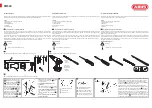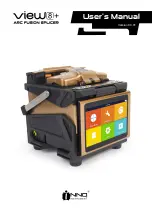
- 6 -
section of this handbook.
- When using machines on wheels: disconnect the spot welder from the
electric and pneumatic (if present) power supplies before moving the unit
to another work area. Pay attention to obstacles and unevenness on the
ground (for example cables and piping).
- UNINTENDED USE
It is dangerous to use the spot welder for any purpose other than that for
which it is intended (see INTENDED USE).
STORAGE
- Place the machine and its accessories (with or without packaging) in closed
areas.
- The relative humidity of the air must not exceed 80%.
- The environmental temperature must be between -15°C and 45°C.
If the machine has a water cooling unit and the environmental temperature is
lower than 0°C: add the indicated antifreeze liquid or completely empty the
hydraulic circuit and the water tank.
Always use suitable measures for protecting the machine from humidity, dirt
and corrosion.
2. INTRODUCTION AND GENERAL DESCRIPTION
2.1 INTRODUCTION
Mobile resistance welding system (spot welding machine) with digital control by
microprocessor. The system can perform numerous hot and spot welding operations
on the sheet metal that are specific to the automobile body shop sector and those with
similar processing of sheet metal.
Their main characteristics are:
- automatic choice of the welding parameters;
- possibility of varying the welding time compared to the value selected automatically;
- limitation of line overcurrent at insertion (insertion cos φ check);
- backlit LCD display that shows the controls and the set parameters;
The spot welding machine can operate on iron sheets with a low carbon content and
on galvanized iron sheets.
2.2 STANDARD ACCESSORIES
- Studder gun without trigger;
- Cable with earth terminal;
- Extractor with blowback;
- Electrode for star washers.
For further details please consult the latest catalogue.
2.3 OPTIONAL ACCESSORIES
- Consumables box;
- Trolley.
For other accessories please consult the latest catalogue
3. TECHNICAL DATA
3.1 RATING PLATE (FIG. A)
The main data relating to use and performance of the spot-welder are summarised on
the rating plate and have the following meanings:
1- Number of phases and frequency of power supply.
2- Power supply voltage.
3- Rated mains power with 50% duty cycle.
4- Mains power with permanent running (100%).
5- Maximum loadless voltage over electrodes.
6- Maximum current when electrodes are shorted.
7- Safety symbols, the meaning of which is given in chapter 1 “General safety rules
for resistance welding”.
8- Current to secondary when running permanently (100%).
Note: The rating plate shown is an example to show the meaning of the symbols and
numbers; the exact values of the technical properties of your spot-welder can be found
on the rating plate of the spot-welder itself.
3.2 OTHER TECHNICAL DATA
General specifications
- (*)Power supply voltage and frequency:
400V ~ 2ph-50/60 Hz
or:
230V ~ 1ph-50/60 Hz
- Electrical protection class:
I
- Insulation class:
H
- Enclosure protection rating:
IP 22
- Weight:
21kg
Input
- Max. power when spot-welding (S max):
13kVA
- Power factor at Smax (cosφ):
0.8
- Main supply delayed fuses:
10A (400V)/16A (230V)
- Automatic circuit-breaker:
10A (400V)/16A (230V)
- Power supply cable (L≤4m):
3 x 2.5mm
2
(400V) - 3 x 4mm
2
(230V)
Output
- Loadless secondary voltage (U
0
max):
5.6V
- Max. spot-welding current (I
2
max):
2.5kA
- Spot-welding capacity (low carbon steel):
max 1.5 + 1.5mm
(*)NOTES:
- The spot-welder can be supplied for a 400V or 230V power supply; make sure the
value on the data plate is correct.
4. SPOT WELDING MACHINE DESCRIPTION
4.1 THE SPOT WELDING MACHINE AND ITS MAIN COMPONENTS (Fig. B)
At the front:
1 - Control panel;
2 - Gun cable attachment (studder);
At the back:
3 - Main switch;
4 - Power cable input;
4.2 CONTROL AND ADJUSTMENT DEVICES
4.2.1 Control panel (Fig. C)
1.
Multifunction button
a) “
START” FUNCTION:
starts the machine at first starting or after an alarm state.
NOTE: Whenever necessary, the display indicates to the operator that he
must press the “START” button to use the machine.
b)
“
MODE
” FUNCTION:
select the studder tool (fig. C-8a / 8e only active with the studder gun).
c) CHOOSING THE UNIT of MEASUREMENT:
keeping this key pressed for 3 seconds, the operator can set the units for
measuring the thickness of the sheets in “millimetres” [
mm
], “gauge” [
ga
] or
inches [
in
].
2-3.
-
/
+
Double function buttons
a) SHEET THICKNESS FUNCTION:
keeping the [
+
] key pressed increases the sheet thickness, while pressing the
[
-
] key decreases it.
b) TIME
SELECTION FUNCTION :
by keeping the [
-
] key pressed for 3 seconds, the welding time
can be
increased or decreased as to the value set automatically by the machine
;
4. LCD display
5.
Signals that the
key must be pressed to prepare the machine for welding.
6.
Shows the sheet thickness and possible alarm codes.
7.
Indicates the Studder gun without trigger (contact version).
8a.
Indicates the spot welding of plugs, rivets, washers and special washers with
suitable electrodes.
8b.
Indicates the spot welding of screws having a diameter of 4-6 and rivets having a
diameter of 5 with suitable electrode.
8d.
Indicates sheet tempering with the carbon electrode.
8e.
Indicates sheet upsetting with the relative electrode.
9.
Indicates the level of the welding time
respect at the automatically set value
.
12.
Indicates that the clamp being used is energised.
13.
activated using the Studder gun.
16.
Is the thickness of the sheet to be welded.
17.
Indicates that the machine is being thermostatically protected.
19.
Indicates the measurement unit of the metal sheet thickness .
4.3 SAFETY FUNCTIONS AND INTERLOCK
4.3.1 Safeguards and alarms (TAB. 1)
a) Thermostatic safeguard:
Intervenes if the spot welding machine overheats because the cooling liquid is
missing or is insufficient, or due to a work cycle that exceeds the permitted limit.
The icon on the display (fig. C-17) switches on to signal intervention and with:
AL1 = machine thermal alarm.
AL2 = clamp, studder thermal alarm.
EFFECT: current blocked (welding inhibited).
RESET: manual (use the “START” push-button when the permitted temperature
limits are reached - the [symbol] icon switches off).
b) Over and under voltage protection
The intervention is signalled on the display by AL 3 = overvoltage alarm and by AL
4 = undervoltage alarm.
EFFECT: current blocked (welding inhibited).
RESET: manual (use the “START” push-button).
c) “START” push-button (Fig. C-5).
This push-button must be pressed to control welding in each of the following
conditions:
- when the master switch is switched off (pos “O” => pos “I”);
- each time the safety/protection devices cut in;
- after the power supply (electricity and compressed air) has been returned after
being disconnected upstream or after a failure;







































